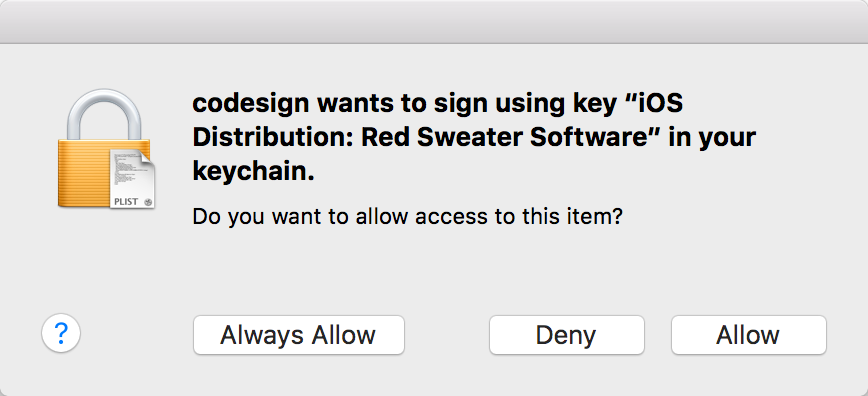It’s common to use a remote, headless build server to perform iOS or Mac builds for which the “codesign” tool must be run to sign either the resulting binary, the installer package, or both.
My friend Mitch Cohen raised a concern on our local CocoaHeads that, since 10.11.1 was released, there is a problem with such setups. The dialog that pops up when using a code signing identity for the first time ignores clicks to the “Allow” and “Always Allow” buttons:

If you look in the system Console, you see a line along the lines of this, correlated to each attempted click of an “Allow” button:
3/15/16 8:51:55.303 AM SecurityAgent[65532]: Ignoring user action since the dialog has received events from an untrusted source
The changes are apparently rooted in a legitimate security update made by Apple, but the end result for us developers is pretty bleak. It’s seemingly impossible to authorize use of a code signing identity on a remote server. As my friend Mitch put it, he has to call IT and “get someone to go into the data closet” every time this happens. What a drag!
I’m also affected by this issue, since I use a headless Mac Mini as a build server. Lucky for me the server is in my house, but it’s still a drag to have to go log in and control the computer with an attached keyboard.
I poked around for a solution to this problem, and found it lurking in the answers and comments of a Stack Overflow question. The basic idea is you can convince OS X to trust codesign to use the tool, just as if you had clicked the “Allow” button in that UI prompt. Here is a recipe for doing just that, logged in as a remote user over say Screen Sharing:
- Open Keychain Access and locate the pertinent private key. You may have to click on the “Certificates” section and then type in part of the name of the identity in question, e.g. “iPhone Distribution”:

- Click the private key and then select File -> Export Items from the menu bar. Save the item anywhere on your server, for example the Desktop. Give it a password e.g. “hardpassword”.
- Now stop. Think real hard before you continue. You should have a backup of that private key somewhere. If you don’t? Don’t continue. Did you just make a backup to the Desktop? Yes, in theory. But if these are the only two copies of this private key you need to think long and hard before you continue with the next step, which I absolutely do not advise you to do.
- Delete the private key from your keychain. This is the scary (see above), but necessary step to get the Keychain to respect the new permissions you’re going to grant the key in a minute.
- Switch to the Terminal and issue a command like the following:
security import ~/Desktop/Certificates.p12 -k ~/Library/Keychains/login.keychain -P hardpassword -t priv -T /usr/bin/codesign -T /Applications/Utilities/Keychain\ Access.app
It may be important to specify the path to the specific keychain, and to belabor the point you’re importing a private key with the “-t priv” parameter. It seemed like maybe things weren’t working for me until I deigned to include these. In any case, the goal here after running this command is that the private key shown in the screenshot above should now be back in your keychain, but if you double-click it to examine its permissions, you’ll find that codesign is listed among the approved apps. If you need to provide access to other tools than codesign, list them as shown above with multiple -T parameters to the “security import” command.
In my tests that seems to address the issue. After following the recipe above carefully, I can remotely “codesign” with the specified identity to my heart’s content, without a UI prompt of any kind.
It strikes me that this trick probably shouldn’t work, at least in light of Apple’s clamping down on the ability to change authorizations through the UI of Keychain Access. So I won’t be surprised if this series of tricks doesn’t stand the test of time. For now though? No need to call IT and have them go into the data closet.
Update: Erik Schwiebert reports that Apple has addressed this problem in 10.11.4 betas:
@mjtsai @danielpunkass clicking keychain dialog buttons via remote access@works again in 10.11.4 beta 4.
— Erik Schwiebert (@Schwieb) March 15, 2016
@mjtsai @danielpunkass when you do so the OS will prompt you for your password again to confirm human instead of UI scripting attack.
— Erik Schwiebert (@Schwieb) March 15, 2016
That’s great news!